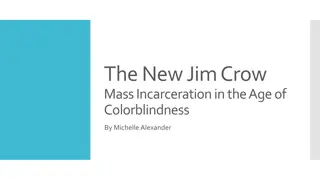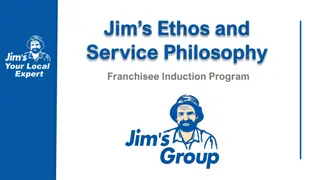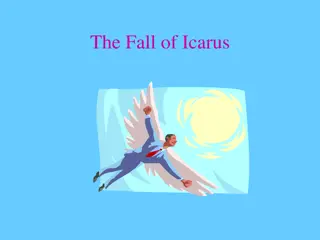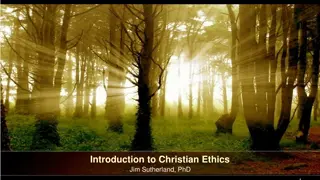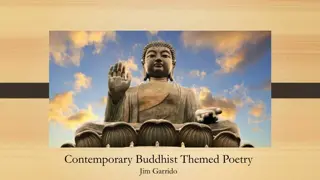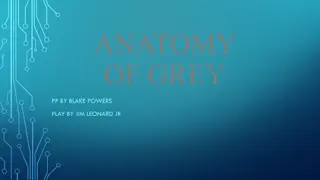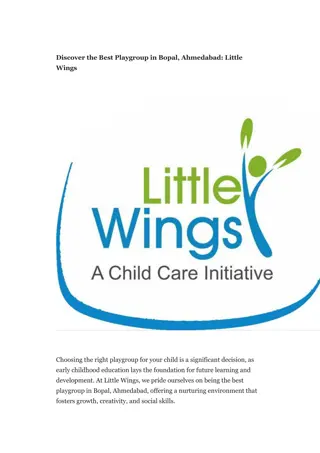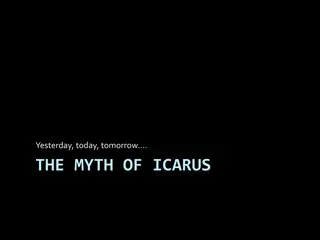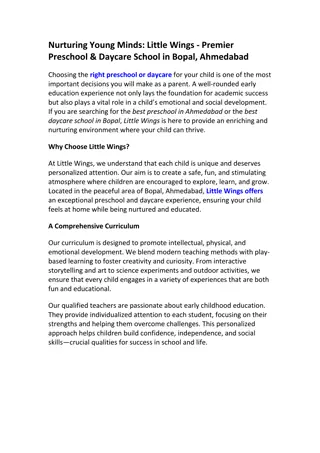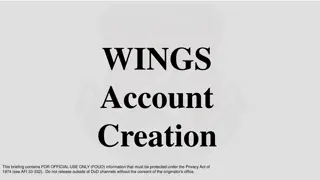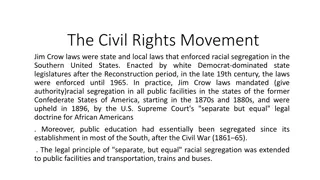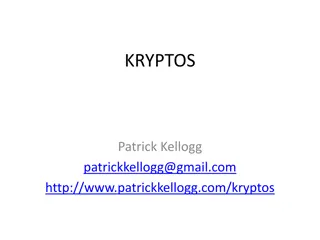Overview of the Ten Wings in "The Ten Wings: An Overview" by Jim Cleaver
The Ten Wings, as discussed in "The Ten Wings: An Overview" by Jim Cleaver, delve into various aspects of the I Ching philosophy. The book breaks down the significance of each wing, such as the Great Treatise and Image Commentary, offering insights into divination and interpretations of the hexagrams. Additionally, it explores the Upper and Lower Canon, shedding light on the historical context and evolution of these foundational texts.
Download Presentation

Please find below an Image/Link to download the presentation.
The content on the website is provided AS IS for your information and personal use only. It may not be sold, licensed, or shared on other websites without obtaining consent from the author.If you encounter any issues during the download, it is possible that the publisher has removed the file from their server.
You are allowed to download the files provided on this website for personal or commercial use, subject to the condition that they are used lawfully. All files are the property of their respective owners.
The content on the website is provided AS IS for your information and personal use only. It may not be sold, licensed, or shared on other websites without obtaining consent from the author.
E N D
Presentation Transcript
Intro Defining the term Zhuan The most significant of the 10 Wings philosophically, is the 5th & 6th, known as the Great Treatise ( D Zhu n). This Wing comprises the bulk of Book II in the Wilhelm translation. (pp. 280-355) Stephen Karcher has more recently produced a version entitled TA CHUAN The Great Treatise The Key to Understanding the I Ching and Its Place in Your Life (2000). I propose a better translation of Da Zhuan would be the Great Commentary. Because zhu n literally means to comment on or a commentary and because we commonly translate l n as treatise .
Intro Defining the term Xiang For divination, the most important Wings are 3 & 4, called The Image ( / Xi ng) Commentary (Zhuan). So why is the Image given two Wings? At first glance one might assume the division is due to the fact that there are two commentaries, the Large and Small Images (D Xi ng & Xi o Xi ng). The Large(r) Images identifies and comments on the two component trigrams in each hexagram. Even books that leave the Wings out will usually include these. Wilhelm titles them The Image. The Small(er) Images pertain to the line texts. (in Wilhelm these are only found in Book III, under heading b)
Intro: Da Yan Upper & Lower Canon Actually, the reason for two Wings, is that since the D Y n (the Great Extension/Expansion), a section of the Great Commentary, written ~100 BCE, the 64 hexagrams have been divided into two sections. Known as: The Upper Canon (Sh ng J ng), hexagrams 1-30 and the Lower Canon (Xi J ng) H: 31-64. The reason for this division is unknown. It does suggest that the lower numbered Wings were all written after or along with the Da Yan, despite their earlier numbers, but this too is uncertain. The Da Yan chapter (IX in Wilhelm, p.308) is primarily concerned with numerological aspects of the Yi.
Wings 1 & 2 Comments on the Decisions/Determinations/Judgments Tu n Zhu n: Pinyin = Tuan WG = T uan Missionary = Thwan This is a commentary on the basic text for each hexagram, which are titled Tuan = Judgment or Decision. The character tuan is the picture of a pig or boar s head, probably related to use in sacrificial offerings, but in the context of the Yi Jing is generally translated as decision or determination . There is a Tuan and a Tuan Zhuan/Commentary for each of the 64 hexagrams. The Tuan were written by King Wen, usually the first words/text after the Hexagram s title/name. The Tuan Zhuan/Commentaries were written by later (unknown) commentator(s). They have sometimes attributed to Confucius (Master Kong, Kong Fu-zi). This is not true, but they are certainly Confucian (Ru) in tone. In Wilhelm they are found in Book III, starting on p.370. An Index to the Wings may be found on p.xix Wilhelm translates as: Commentary on the Decision Rutt translates as: Commentary on the Hexagram Statements Nielsen translates as: The Commentary on the Decisions distinguishing from Tuan Ci = Deciding Remarks
Why Two Wings? Remember the reason there are two wings is because the commentary is divided into two parts corresponding to the division of the Yi as whole into so-called Upper and Lower Canons. The Upper Canon is comprised of hexagrams 1 to 30. The Lower Canon is comprised of hexagrams 31 to 64. The two wings are really just one commentary. This pattern holds for the first six Wings, they are really just three. This means there are really only Seven Wings.
Clarifying In Wilhelm, this commentary is to be found in Book III, starting on page 370, under the title Commentary on the Decision. In a footnote Wilhelm makes it clear that the terms Judgment and Decision are equivalent. (I think he uses the two words to help preserve a distinction between these two components of the text.) Judgments are what King Wen wrote (Tuan), while Decision refers to the words of later commentators as recorded in the Wings (Tuan Zhuan). This commentary helps to explain the Judgment which immediately precedes it.
Back to the text itself: The Tuan-zhuan are relatively short passages on each hexagram, ranging from 27 characters (in T:17) to 91 characters (for T:32). They average is 45 characters, yielding a text around 2900 characters long. They start with an identification of the hexagram under discussion, though often somewhat obliquely. The hexagrams are never identified by number the way we do now, but by their name or attributes that correspond, usually to its component trigrams or distinctive lines. In ancient Chinese these passages rhymed, which may in part explain their cryptic and truncated style. Their ultimate goal was to explain the meaning attached to the hexagram, especially its portend.
Some Specific Contents are worth Noting Many Important interpretive concepts are first mentioned here such as: (see BN p. 239 / see also Yao p. 289-300) Correct and Incorrect positions Matching positions Attaining or Losing the position Central position or Central & Correct Venerable/respected position (the 5th)( z n w i) Responding or Corresponding Waning & Waxing ( zh ng w i) ( d ng w i / w i bu d ng) ( d w i / sh w i) ( zh ng w i / zh ng zh ng) ( y ng / wulacksying) ( xi o x ) * These concepts will be discussed later in the course. They pertain to relationships between lines within the hexagram.
Wings 3 & 4 Commentary on the Images/Symbols / Xi ng Zhu n: PY = Xiang WG = Hsiang There are two distinct commentaries here. One known as the Greater/Larger Images (Da Xiang) and one called the Smaller/Lesser Images (Xiao Xiang), These are not the two wings as one might initially suppose, but two different texts. The Greater Images pertain to the hexagram, whereas the Lesser Images pertain to the line texts. They are however, also split, into two wings as a result of dividing the hexagrams into upper (1-30) and lower (31-64) canons, as it was for Wings 1 & 2.
The Da Xiang The Da Xiang Commentary identifies the two trigrams for each hexagram, and the lesson(s) that a jun-zi or the ancient kings (founding fathers) extracted, based on understanding of them. There are 64 of these. They are relatively short and formulaic. They range in length from 8 to 22 characters, and total 997 characters This total includes the two characters that start each line, Xiang Yue = The Image says:, which account for 128 characters, leaving 869 for the actual content of the commentary.
The Xiao Xiang The Xiao Xiang is a commentary on the line text for line of each of the 64 hexagrams. Thus, there are 384 of these (6x64). Wilhelm identifies them as b) under the line texts in Book III of his work. This text is more like the Tuan commentary and could be considered an extension of it. It does not deal with the trigrams or their images as the name might suggest.
Wings 5 & 6 aka X C Zhu n: Comments on the Appended Statements D Zhu n: The Great Commentary PY = Da WG = Ta ( t without an apostrophe is pronounced like a d ) How we should translate the title is something of an issue here. Most sources have dubbed it the Great Treatise. Zhuan literally means to comment on , or a commentary , thus I translate it as the Great Commentary, or Great Comments, or Enlarged Commentary, rather than, Great Treatise. We often translate l n as a treatise too, though that could also perhaps be better translated as a Discussion or Discourse , freeing up treatise altogether. The most famous example is the L n Y , usually translated as The Analects (of Confucius) or Confucian Analects. (the 2ndtone l n is reserved for this text)
Da Zhuan Given its importance, relatively few translations of the Da Zhuan exist in English. In chronological order they are: James Legge (1899), Wilhelm/Baynes (1950), (constitutes the bulk of Book II) Gerald Swanson (1974) (dissertation), Wu Jing-nuan (1991), Richard Lynn (1994), Richard Rutt (1996) and the only dedicated book, by Stephen Karcher (2000).
Da Zhuan The Da Zhuan constitutes two of the 10 Wings and are designated as Wings 5 & 6. This is however, because the work itself is divided into two parts, not for the two canons reason. The two parts are usually differentiated by Roman numerals as Part I or II. In each of the two parts there are 12 subsections (Wu divides into 11 each), which are further delineated into paragraphs or lines which are also numbered for clarity. Wilhelm and Rutt have titled the subsections. Rutt s are more synoptic, so I list his first, but include both versions here. There are clear parallels to be seen between the two Parts/Wings.
Da Zhuan Part I = Wing 5 12 Subsections # Section Titles Cosmic Analogies Omens Statements (Judgments) Yi & Dao Dao & Yin-yang Yi embraces Heaven & Earth Yi is Supreme Line Commentaries Stalk Counting Symbolism The Fourfold Dao of Yi The Sages and Spirits Miscellany # of Paragraphs / Lines 8 6 5 4 9 3 2 11 10 7 9 7 Wilhelm p. 280 p. 280 p. 287 p. 290 p. 293 p. 297 p. 301 p. 302 p. 304 p. 308 p. 314 p. 316 p. 321 1. 2. 3. 4. 5. 6. 7. 8. 9. 10. 11. 12. Changes in the Universe On Composition & Use On the Words Attached Deeper Implications Dao: Light & Dark Power Dao Applied to the Book Effects of the Book on Man Use of the Appended Explanations On the Oracle The Fourfold Use of the Book On the Yarrow Stalks Summary
Da Zhuan Part II = Wing 6 12 Subsections # Section Titles # of Paragraphs / Lines Wilhelm p. 325 1. 2. 3. 4. 5. 6. 7. 8. 9. 10. 11. 12. Cosmic Analogies The Sage Inventions The Figures and their Statements The Trigrams Line Commentaries The Statements (Judgments) Uses of Nine Hexagrams Alternation Line Positions Yi Contains all Dao Cautions Miscellany 8 13 4 3 14 4 4 4 6 2 1 7 p. 325 p. 328 p. 336 p. 337 p. 338 p. 343 p. 345 p. 348 p. 349 p. 351 p. 352 p. 353 On the Signs and Lines History of Civilization The Structure of Hexagrams The Nature of the Trigrams Explanation of Lines On the Nature of the Book 9 Hexagrams and Character Using the Changes: Lines Lines (cont.) Lines (cont.) The Value of Caution Summary
Wing 7 W n Y n: Words on the Text Wen is the same wen as in Wen Wang (King Wen), so could be translated as On Wen s Words Wilhelm: Words of Rutt: Words (Glosses or Elegant Words) Nielsen: Refined Words This commentary is brief and only deals with the first two hexagrams (which are the doorways to the other 62) The Wing may be brief, but Wei Tat wrote a 600 page translation of it. It comments on both Judgment and Line texts, i.e. there are two parts to this wing, (actually four, lines & J/D comments for both H:1 & 2)
Wing 7 Wn Yn In Wilhelm these are found in Book III and listed under a heading called On the Hexagram as a Whole. There are actually four distinct commentaries for Hexagram 1. These are labeled: a), b), c), and d) There is only one for Hexagram 2 This commentary is considered to be an important source of information concerning the four terms: yuan, heng, li, zhen. We will revisit them later. (see p.375 385) (see p.392 397).
Wing 7 Wn Yn Wei Tat s 600 page tome An Exposition of the I Ching (1977) is a discussion of the ten Wings in general, with the bulk of its pages (119-588) devoted to all the specific commentaries on Hexagrams 1 & 2. Hexagram 1 extends from p. 119-355 Hexagram 2 goes from p. 361-583. Pertaining to this Wing: Hex: 1 p. 267-355 = 86 pages Hex: 2 p. 521-583 = 62 pages (divided into 36 paragraphs) (divided into 10 paragraphs) * There is a good presentation on the four attributes (p. 267-273), which is continued under Hex 2 on p. 375-379.
Wing 8 Shu Gu Explaining the Gua (Hexagrams and/or Trigrams) Wilhelm: Lynn: Rutt: Legge/Sung: Nielsen: Discussion of Trigrams Explaining the Trigrams Explanation of the Trigrams Remarks on the Trigrams Explaining the Trigrams As a title I m going to go with Explaining [the] Trigrams, or more colloquially as Talking [about] Trigrams Everybody agrees that gua here just means trigrams, and the text itself confirms this.
Wing 8 Shu Gu Talking Trigrams Though only one Wing, it is typically divided into two parts with multiple zhang/sections. Kong Yingda s (574-648 CE) version has 17 sub-sections. Zhu Xi s version (1130-1200 CE) divides into 11 sub-sections. Part I: Zhang=sections/chapters/paragraphs 1-3, deal mostly with general principles and history, similar to the Da Zhuan=Great Commentary (Wings 5 & 6). Paragraph 4 in Kong-YD or 4-5 in Zhu-Xi, discusses the cosmological sequence of trigrams and is the source of the delineation: Xian Tian = Earlier/Former Heaven sequence (of trigrams). Hou Tian = Later/Latter Heaven sequence (of trigrams).
Wing 8 Shu Gu Talking about Trigrams Part II: which may also be divided into two parts, is longer and deals mostly with Trigram correspondences. Hence, the emphasis by most translators of this Wing as focused on Trigrams. It is a relatively systematic assigning of attributes and correspondences that are understood to be representative associations of the individual trigrams. KongYD/ZhuXi Paragraph 5/6 Paragraph 6/7 Paragraph 7/8 Paragraph 8/9 Paragraph 9/10 Paragraph 10-17/11 lists physical and mental characteristics lists animals lists body parts lists family members a catalog of images referred to as extended images ( gu ng xi ng) a further cataloging of correspondences sometimes referred to as escaped or lost images ( y xi ng)
Former Heaven Sequence East SE South SW West NW North NE Li/fire Dui/lake Qian/heaven Xun/breeze Kan/water Gen/mt. Kun/earth Zhen/thunder
Latter Heaven Sequence East SE South SW West NW North NE Zhen/thunder Xun/breeze Li/fire Kun/earth Dui/lake Qian/heaven Kan/water Gen/mt.
Wing 9 On the Sequence of Hexagrams X Gu : Wilhelm: Lynn: Rutt: Wu Legge/Sung: Nielsen: Sequence of the Hexagrams Providing the Sequence Ordered Hexagrams An Orderly Sequence On the Orderly Sequence of the Hexagrams Ordering the Hexagrams * In this Wing, Gua is understood to refer to the Hexagrams Specifically the King Wen order (1-64) of the hexagrams in a narrative form.
Wing 9 X Gu: The Sequence of Hexagrams In Wilhelm it is divvied up and presented under the individual hexagrams in Book III and listed under the heading The Sequence . This commentary is quite mnemonic and it would appear that its primary purpose was not so much about explaining the order of hexagrams, but for memorizing it.
Wing 9 X Gu: The Sequence of Hexagrams Actually, only 61 of the 64 hexagrams are mentioned by name. The text begins with Heaven and Earth, which are obvious corollaries to Qian and Kun (H:1 & 2). What follows Li (H:30) does not mention Xian H:31 by name, but instead speaks again of H & E, which produce all things including man & woman, husband & wife, which corresponds with traditional interpretations of H:31 Xian as Attraction (to the opposite sex), and H:32 Heng/Constancy/Enduring as having to do with Marriage. Thus, once again we have a kind of division of the text into upper and lower canons after H:30, though in this instance it all remains classified together as one Wing.
Wing 10 Hexagrams Z Gu : Co-Mingling Miscellaneous Notes on Hexagrams Wilhelm: Misc. Notes Lynn: Irregular Order Rutt: Mingled Hexagrams Wu: Mixed Order Legge: translates this as Hexagrams Taken Promiscuously, According to the Opposition or Diversity of their Meaning Wilhelm divides this commentary up and places the separated comments within the relevant Hexagram in Book III. These are labeled Miscellaneous Notes .
Wing 10 Z Gu Miscellaneous Notes on Hexagrams This commentary employs a unique style in that it presents the gua in pairs, but mixed up and sometimes in reverse order. It uses a rhyming scheme that undoubtedly was designed to facilitate memorization. The following tables list the hexagrams in pairs, in the order in which they are presented in the Za Gua.
Wing 10 Z Gu Miscellaneous Notes In this table I have arranged the pairs in rows of eight across: Read Left to Right: 1/2 15/16 59/60 55/56 55/56 55/56 1/2 15/16 1/2 15/16 59/60 59/60 8/7 21/22 40/39 30/29 30/29 30/29 8/7 21/22 8/7 21/22 40/39 40/39 19/20 58/57 19/20 58/57 38/37 38/37 19/20 58/57 38/37 9/10 9/10 9/10 3/4 17/18 12/11 5/6 5/6 5/6 3/4 17/18 3/4 17/18 12/11 12/11 51/52 23/24 34/33 34/33 51/52 23/24 34/33 28 28 28 51/52 23/24 41/42 35/36 14/13 44/53 44/53 44/53 41/42 35/36 14/13 14/13 41/42 35/36 26/25 48/47 49/50 27/63 27/63 27/63 26/25 48/47 26/25 48/47 49/50 49/50 45/46 31/32 62/61 54/64 54/64 54/64 45/46 31/32 62/61 62/61 45/46 31/32 43 43 43
Wing 10 Z Gu Miscellaneous Notes All 64 hexagrams are presented but The overall pattern is quite mixed, with no apparent pattern or logic to the sequence. 11 pairs are in reverse order (shaded). The last 8 hexagrams are even more mixed. These are separated from the rest by the double-line box. H:43 is an interesting choice for the final hexagram, and I think not random. It is composed of five yang lines in the first five positions, leaving one last yin line at the top. When this line is changed to a yang line, it will convert it to hexagram 1, and thus return to the beginning H:1.
Wing 10 Z Gu Miscellaneous Notes In this table I try show the rhyme scheme, following Rutt s translation. The rhyme is only apparent when one drops the final particle ye, which is present in all but six of the lines. The vertical double line here represents a change between rhyme groups: 1/2 21/22 38/37 30/29 8/7 58/57 12/11 9/10 19/20 17/18 34/33 5/6 3/4 23/24 14/13 28 51/52 35/36 49/50 44/53 41/42 48/47 62/61 27/63 26/25 31/32 55/56 54/64 45/46 59/60 15/16 40/39 43
Wing 10 Z Gu Miscellaneous Notes Thus it seems to go: 8-4-6 6-2-6-4 6-6-2 4-3-2-2-2-1 = 18 hexagrams = 18 = 14 = 14 The 5/6-28 in the bottom row constitutes a triplet. The rhyme pattern in H:43 repeats that used in H:1/2-8/7 at the beginning. The poem lines themselves vary in length from 2 to 7 characters.




